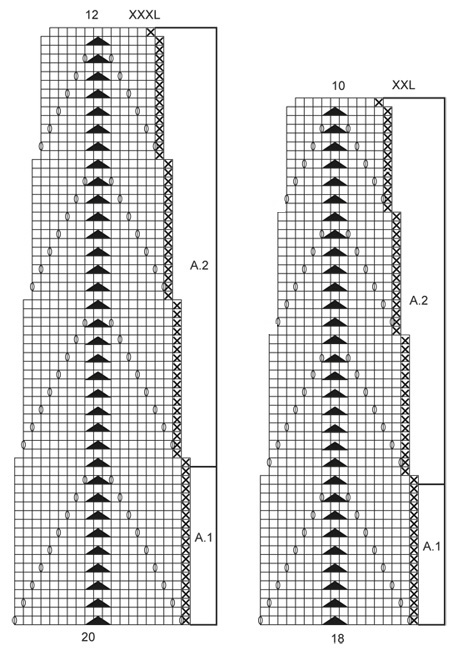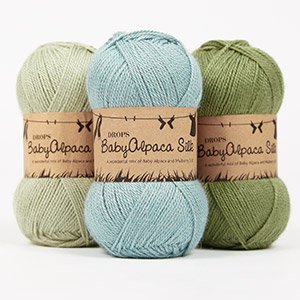Comments / Questions (210)
![]() Glenn wrote:
Glenn wrote:
Visst framgår det! Rader i A2 med bara en svart triangel utan motsvarande omslag minskar ju maskantalet.
04.11.2013 - 11:30
![]() Gittan wrote:
Gittan wrote:
Hej! Har stickat fram/bakstycket och ärmar, men får inte ihop mönstret efter ihopsättningen. Rimligen borde man minska antalet maskor regelbundet när man stickar A2,men det framgår inte av beskrivningen. Kan jag få en förklaring.
03.11.2013 - 18:47DROPS Design answered:
Antalet maskor minskas regelbundet när du följer diagrammet. Du ser att det i diagrammet regelbundet finns en minskning utan omslag i varje sida. Lycka till :)
04.11.2013 - 11:42
![]() Jacqueline wrote:
Jacqueline wrote:
Dus als ik goed begrijp bij het patroon A2 wordt er in het patroon geminderd
22.10.2013 - 14:47DROPS Design answered:
Dat klopt, in een aantal naalden in het patroon zie je wel minderingen en geen omslagen, vandaar dat het patroon in de hoogte ook steeds smaller wordt. Succes!
22.10.2013 - 17:46
![]() Marianne wrote:
Marianne wrote:
Dankjewel voor het antwoord op min vorige vraag. Ik was er intussen zelf ook al achter gekomen ;-) Nu ben ik op het punt gekomen dat ik moet beginnen met de mouwen en dat wil niet goed lukken. Ik heb nog nooit met vier naalden gebreid en het lukt mijn niet om mijn cirkel mooi dicht te krijgen onderaan. Hebben jullie tips voor mij? Ook zou ik graag weten hoe ik dit patroon het beste kan breien op vier naalden om omslagen te vermijden op het einde van een naald. Alvast bedankt. groetjes, Marianne
21.10.2013 - 16:53DROPS Design answered:
Kijk bij onze instructievideo's voor meer hulp en uitleg: https://www.garnstudio.com/lang/nl/video.php?id=42. Een omslag aan het einde van de naald is geen probleem, gewoon de draad om de naald slaan en met een vinger of uw duim tegenhouden.
22.10.2013 - 08:44
![]() Elfriede Greslehner wrote:
Elfriede Greslehner wrote:
Ich finde ja ihre anleitungen super toll. wäre es nicht möglich, dass die anleitungen als pdf zum herunterladen eingestellt werden? das wäre eine grosse erleichterung wenn man die modelle nachstricken möchte. hoffe ich finde noch viele tolle anleitungen auf ihrer seite. mfg elfriede g
20.10.2013 - 13:40DROPS Design answered:
Liebe Elfriede, es freut uns, dass Sie mit unseren Anleitungen so zufrieden sind. Sie können die Anleitungen ganz einfach von unserer Seite ausdrucken (indem Sie den Button DRUCKEN: ANLEITUNG anklicken). Oder Sie kopieren sich die gewünschten Anleitungsteile in ein Worddokument.
21.10.2013 - 09:03
![]() Jacqueline wrote:
Jacqueline wrote:
Bij de pas begin met 288 st.na patroon A2 heb je nog 160 st. hoe minder ik dan die 128 st.
19.10.2013 - 09:47DROPS Design answered:
Dit staat in het patroon: Als A.2 klaar is, staan er nog 96-128-160-192 st op de nld. Brei 1 nld recht en minder TEGELIJKERTIJD in de 1e nld 22-50-68-92 st gelijkmatig = 74-78-92-100 st. U hebt dus 160 st over, mindert 68 st gelijktmatig en houdt 92 st over, geen 128 st.
21.10.2013 - 08:28
![]() Lyda wrote:
Lyda wrote:
Probleme pour ce modele.comment faire un jeté entre deux mailles envers,sur les mailles endroit pas de problème,mais entre deux mailles envert,je suis bloquée
11.10.2013 - 16:08DROPS Design answered:
Bonjour Lyda, pour faire 1 jeté entre 2 m env, procédez ainsi: fil devant, tricotez la 1ère m env, passez le fil par-dessus l'aiguille droite et faites le revenir entre les 2 aiguilles (dans le sens des aiguilles d'une montre), le fil est de nouveau devant l'ouvrage, vous pouvez tricoter votre 2ème m env. Bon tricot!
11.10.2013 - 17:19
![]() Marianne wrote:
Marianne wrote:
Ik ben begonnen met deze pull te breien met ander garen maar met wel dezelfde stekenverhouding. Wat ik niet heb is dat mooie gaatjespatroon. In de beschrijving staat dat je de omslagen die je gemaakt heb om te meerderen in de volgende rij rechts gedraaid moet breien om gaatjes te voorkomen. Moet ik dit nu net niet doen om die gaatjes in het patroon te krijgen?
11.10.2013 - 15:41DROPS Design answered:
Hoi Marianne. Het gedraaid breien van de omslagen is alleen voor het MEERDEREN en niet tijdens het breien van het motief. Hier volg je de beschrijving bij de symbolen en de omslagen worden niet verdraaid gebreid. Veel breiplezier verder
16.10.2013 - 13:45
![]() Lyda wrote:
Lyda wrote:
Bonjour pour debuter ce modelevous dites commencer par un tour point mousse,voir plus haut et la il est marqué.tour pont mousse un rang endroit et un rang envers,c'est la que je ne comprends pas pour moi le point mousse c'est tous les rangs a l'endroit,un rang a l'endroit et un rang a l'envers pour moi c'est du jersey.
09.10.2013 - 14:19DROPS Design answered:
Bonjour Lyda, vous avez tout à fait raison, en allers et retours, on tricote tous les rangs à l'end pour avoir du point mousse, mais ce pull se tricote en rond jusqu'à la fin, et pour avoir du point mousse en rond, on doit tricoter alternativement 1 tour end, 1 tour env - cf vidéo ci-dessous. Bon tricot!
09.10.2013 - 16:00
![]() Giselheid Bicker wrote:
Giselheid Bicker wrote:
Vor vielen Jahren habe ich einen ähnlichen Pullover gestrickt, der aber von oben begonnen wurde. Leider fehlt mir dazu die Anleitung. Kann man mit der Anleitung zu diesen Pullover auch von oben beginnen und dann die glatten Teile auch gleich anstricken? Danke für eine kurze Nachricht.
11.09.2013 - 13:40DROPS Design answered:
Liebe Giselheid, dies würde eine recht komplizierte Umrechnung des Modells bedeuten, wir empfehlen es daher nicht.
18.09.2013 - 08:15
Fox Sweater#foxsweater |
|||||||||||||
|
|
|||||||||||||
Knitted DROPS jumper with round yoke and lace pattern in ”BabyAlpaca Silk”, ”Kid-Silk” and ”Glitter”. Size: S - XXXL.
DROPS 150-7 |
|||||||||||||
|
GARTER ST (in the round on circular needle): * K 1 round and P 1 round *, repeat from *-*. 1 ridge = 2 rounds. PATTERN: See diagrams A.1 and A.2. Diagrams show all rows in pattern from RS. See diagram for size! DECREASE TIP (applies to the body): Dec as follows before marker: K 2 tog. Dec as follows after marker: Slip 1 st as if to K, K 1, psso. INCREASE TIP: Inc 1 st by making 1 YO. On next row/round work YO twisted to avoid holes. -------------------------------------------------------- BODY: Worked in the round on circular needle. Cast on 168-192-216-240 sts on circular needle size 5 mm with 1 strand BabyAlpaca Silk + 1 strand Kid-Silk + 2 strands Glitter. Work 1 RIDGE in garter st - see explanation above. Then work as follows: A.1 over all sts (= 12 repetitions in the round). When A.1 has been worked 1 time vertically, insert 2 markers in piece; 1 after 7th-8th-9th-10th st and 1 after 91st-104th-117th-130th st (= 1 marker in each side, front/back piece = 84-96-108-120 sts). Then work in stocking st. REMEMBER THE KNITTING TENSION. When piece measures 7 cm, dec 1 st on each side of both markers - READ DECREASE TIP (= 4 sts dec). Repeat dec every 3½-4-4½-5 cm 3 more times (= 4 dec in total) = 152-176-200-224 sts. When piece measures 24-26-27-29 cm, inc 1 st on each side of both markers – READ INCREASE TIP (= 4 sts inc). Repeat inc every 3-3-2½-2 cm 3 more times (= 4 inc in total) = 168-192-216-240 sts. When piece measures 38-38-37-37 cm, cast off 14-16-18-20 sts in each side for armhole (i.e. cast off 7-8-9-10 sts on each side of both markers) = 70-80-90-100 sts remain on back/front piece. Put piece aside and knit the sleeves. SLEEVE: Worked in the round on double pointed needles. Cast on 42-48-54-60 sts on double pointed needles size 5 mm with 1 strand BabyAlpaca Silk + 1 strand Kid- Silk + 2 strands Glitter. Work 1 ridge in garter st. Work A.1 over all sts (= 3 repetitions in width). When A.1 has been worked 1 time vertically, continue in stocking st. Insert 1 marker at beg of round (= mid under sleeve). When piece measures 8 cm, inc 1 st on each side of marker. Repeat inc every 5-4-3-2 cm 6-7-8-9 more times (= 7-8-9-10 inc in total) = 56-64-72-80 sts. When piece measures 41-38-34-31 cm (shorter measurements in the larger sizes because of wider shoulders), work A.1 over all sts (= 4 repetitions) - NOTE! Start first repeat of A.1 7-8-9-10 sts before the marker! On last round with A.1 cast off 14-16-18-20 sts mid under sleeve (i.e. cast off 7-8-9-10 sts on each side of marker) = 42-48-54-60 sts remain on needle (= 3 whole repetitions of A.1). Sleeve measures 46-44-41-39 cm. Put piece aside and knit another sleeve. YOKE: Slip sleeves on to same circular needle as body = 224-256-288-320 sts. Work A.1 over all sts (= 16 repetitions in width). When A.1 has been worked one time vertically, continue with A.2 over A.1. Continue the pattern like this. Switch to a shorter circular needle when needed. When A.2 has been worked, 96-128-160-192 sts remain on needle. K 1 round AT THE SAME TIME on 1st row dec 22-50-68-92 sts evenly = 74-78-92-100 sts. Then work an elevation at the back of neck as follows in stocking st, insert 1 marker in middle st (= mid back), cut the yarn and beg here: K 7 sts past marker mid back, turn, tighten yarn and P 14 sts back, turn, tighten yarn and K 21 sts, turn, tighten yarn and P 28 sts back. Continue like this - work 7 sts more on every turn until a total of 56-56-70-70 sts have been worked, turn and K 1 round until mid back again. Work 2 ridges in garter st. Cast off with K from RS. Yoke measures approx. 20-24-27-31 cm (mid front) and entire jumper measures approx. 58-62-64-68 cm. ASSEMBLY: Sew the openings under the sleeves tog. |
|||||||||||||
Diagram explanations |
|||||||||||||
|
|||||||||||||

|
|||||||||||||

|
|||||||||||||

|
|||||||||||||
Have you finished this pattern?Tag your pictures with #dropspattern #foxsweater or submit them to the #dropsfan gallery. Do you need help with this pattern?You'll find 22 tutorial videos, a Comments/Questions area and more by visiting the pattern on garnstudio.com. © 1982-2025 DROPS Design A/S. We reserve all rights. This document, including all its sub-sections, has copyrights. Read more about what you can do with our patterns at the bottom of each pattern on our site. |
|||||||||||||






























































Post a comment to pattern DROPS 150-7
We would love to hear what you have to say about this pattern!
If you want to leave a question, please make sure you select the correct category in the form below, to speed up the answering process. Required fields are marked *.